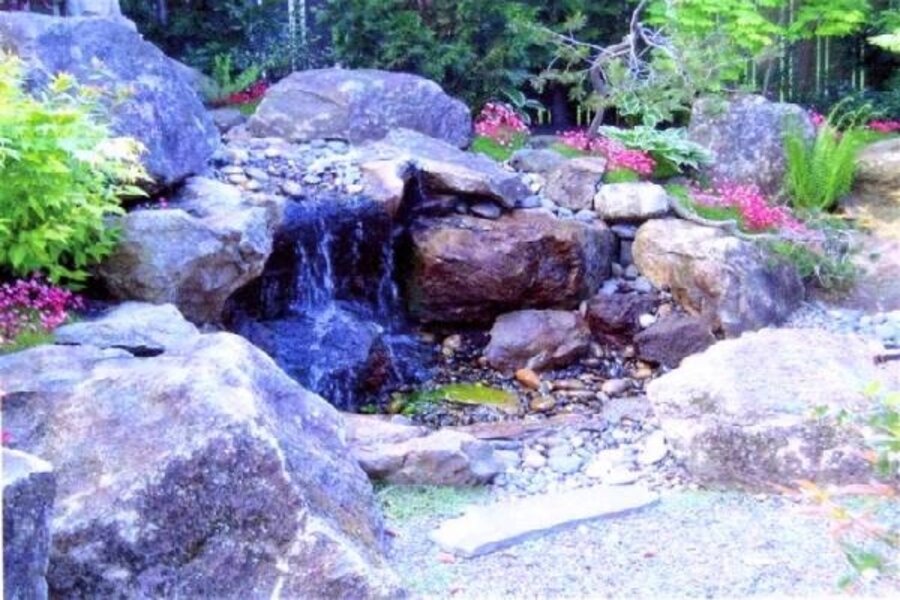A waterfall that really rocks
Loading...
This is the first in an occasional series of stories that will profile people and the water features they love. In Portland, Ore., it took the pressure of a wicked deadline, the good will of neighboring families, and a break in the weather to get this waterfall into the ground.
With a storm threatening, landscape contractor Michael McQuiggin stood in the backyard of the Southwest Portland home, and waved his arms again. High overhead, outlined against a cloudy winter sky, a five-foot-diameter boulder dangled from a long thick cable.
On the hillside above, a large crane, engines growling, shifted the rock to the left, and slowly lowered the enormous load to the place where the Michael was pointing. He gestured one way, and then another. The crane operator responded to the adjustments like a long-distance dancer.
Finally, the boulder settled on a protective pad of felted landscape fabric. It fitted neatly in a sculpted hole carved into the hill swathed with sheets of pond liner.
Michael stepped back. He narrowed his eyes. Did it look right? No.
With a wave of his arm, he signaled the crane, which obligingly rehoisted the rock a foot off the ground. Two workers rotated it a quarter of a turn and Michael motioned for it to be set back down. He checked again.
“OK,” he shouted up to a crew member standing among the 40 tons of rock on the hillside. “Send me a squat one.”
Michael’s company, McQuiggin Inc. uses as its motto, “The difficult we can do — the impossible takes a little longer.”
This installation was almost the impossible and time was running out.
“In typical fashion,” homeowner Dana Upshaw now says with a laugh, “we waited until the last minute.”
She and her husband, Dave Preston, had years to think about what kind of water feature they wanted. For two decades — while raising their children — they had lived with a hillside backyard that Dave describes simply as “boring.”
A neighbors’ remodel jump-started their decision.
The only access for heavy equipment to get to Dana and Dave’s backyard was above them, through the neighbors’ yard. Late that fall, those folks had decided they needed an addition to their house. They would break ground at the beginning of January. The window of opportunity for Dana and Dave’s waterfall was closing in a matter of weeks.
In November, Michael McQuiggin took on the job. The couple wanted a waterfall so the splashing would mask noises and conversation from the adjoining yards. They wanted it without a pond for low maintenance.
The landscape company would have, at best, 21 days. With breaks for the holidays and the winter storms that regularly blow in from the Pacific Ocean, the actual working time was impossibly short.
But Michael likes challenges. “I eat these things up. I thought, we can do it, if we do it just right,” he says.
The crew started work the second week in December. The neighbors offered to let the landscape workers use their yard as a staging area. A large gravel landing — which later became the foundation for the house addition — was built on the uphill site so dump trucks could back in and deliver materials. The landing also supported the crane that then delivered the massive stones to the yard below.
When boulders started flying in, Dana says, “It was frightening — and exciting – but it was a wonderful thing to watch Michael work. He was so meticulous. He didn’t just slap rocks in there. He would have the crane guy lift it again and again, and you’re thinking, what difference does it make?”
The difference for Michael is in the patterns of the stones.
He likes using a local Columbia Gorge basalt because it is more porous, has more character. “The rocks will tell you,” he says. “There’s a grain to them. You can see when you set a stone, that’s the way it’s meant to be. If you put it too upright, or if it breaks the rhythm, it won’t look right.”
The winter storms kept pummeling them — cranes can’t operate in high winds. But crew members grabbed every chance they could to keep on building. Doing the impossible came down to the wire. They finished with two days to spare.
Dana and Dave hope the next people who buy their house like this waterfall as much as they do because, as Dave notes, “These rocks aren’t going anywhere now.”
Mary-Kate Mackey, co-author of “Sunset’s Secret Gardens — 153 Design Tips from the Pros” and contributor to the “Sunset Western Garden Book,” writes a monthly column for the Hartley Greenhouse webpage and numerous articles for Fine Gardening, Sunset, and other magazines. She teaches at the University of Oregon’s School of Journalism & Communication. She will be writing about water in the garden for Diggin’ It.
Editor’s note: To read more by Mary-Kate, check our blog archive. Gardening articles on a variety of topics can be found at the Monitor’s main gardening page. Also see our RSS feed. You may want to visit Gardening With the Monitor on Flickr. Take part in the discussions and get answers to your gardening questions. If you join the group (it’s free), you can upload your garden photos and enter our next contest.





